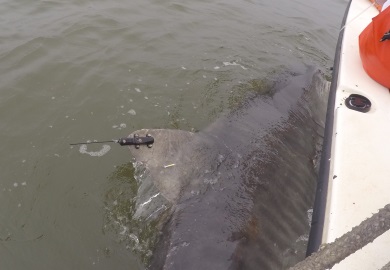
Harry-Ette will help biologists with tiger shark research
As a part of ongoing research on sharks along South Carolina’s coast, SCDNR biologists recently tagged 12-foot, 4-inch female tiger shark with a satellite transmitter in Port Royal Sound. This will help biologists get a better understanding of this species and of what makes South Carolina’s coastal waters such an integral part of the lives of tiger sharks.
The abundance of tiger sharks had been decreasing in recent decades, and their numbers are definitely down. Recent studies have shown a promising trend though, as their numbers are beginning to increase.
Bryan Frazier, an SCDNR biologist and investigator on the agency’s tiger shark tagging program explains the recent rise in tiger sharks numbers. “Because tiger sharks are relatively fast growing and have larger litters, they’ve been able to bounce back quicker than other large sharks,” he said.
This shark, named Harry-Ette, is the twelfth tiger shark to be tagged with a satellite transmitter in South Carolina’s waters. Along with the SCDNR, OCEARCH, the College of Charleston, and Capt. Chip Michalove of Outcast Charters in Hilton Head have been working to find out more details about tiger sharks. Until recently, surprisingly little was known about the details of tiger sharks’ lives, such as how long they typically live, their reproductive rates and habits, migratory information, and even how the waters they inhabit are beneficial to the species.
All twelve tiger sharks fitted with the transmitters were tagged in Port Royal and St. Helena Sounds. Each time one of these sharks breaks the surface of the water, important data is transmitted pieces of information that are vital to the study.
“The recent capture of Harry-Ette, as well as another mature female tiger, both with fresh mating wounds, leads us to believe that Port Royal South and South Carolina nearshore waters are likely important to the reproductive cycles of tiger sharks, perhaps even functioning as a mating area. We look forward to following Harry-Ette over the next few years, and hope she will help us better understand the reproductive cycle and movements of mature/pregnant tiger sharks,” said Frazier.
One of the coolest features for anyone interested in these studies is the ability to track Harry-Ette and all the tiger sharks involved in this study by using the near-real time, online Global Shark Tracker by visiting the OCEARCH website, or by downloading the Global Shark Tracker App, which is available for both Apple and Android platforms.





Be the first to comment